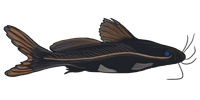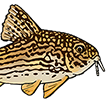Corydoras duplicareus vs C. adolfoi ID help needed
Corydoras duplicareus vs C. adolfoi ID help needed
Hello all,
In an effort to sort out some of the 20 odd Corydoras duplicareus or C. adolfoi I have around the house, I've brought home a 20X stereo microscope home from work for the weekend. According to the species description on this website for C. duplicareus , it should have "Pectoral fin spine serrated on C. duplicareus, smooth on C. adolfoi.". I know, look at the width of the black stripe on the back to tell them apart. It'll tell the difference. So what do you do with the fish with medium width stripes? I'm looking for a positive ID method and I thought looking closely at the spines would do it. It hasn't. Fish with very wide black back stripes (bought as C. duplicareus) have the same look to their spines as my fish with very narrow back stripes (bought as C. adolfoi).
The scope works great. I can see every detail on the spine including the texture and the blood moving through it. I just need someone to point me in the right direction if they've done this before.
The fish are spawning and I'm getting eggs and fry. I'd like to distribute them to my local club with the correct name attached.
Has anyone else been successful ID'ing these guys in this manner? I can't tell one from another. They all look very similar.
Though I've been reading the list and spawning several cories, this is my first post. Thanks in advance for your thoughts.
Ken
[Mod edit: Use persistant link --Mats]
In an effort to sort out some of the 20 odd Corydoras duplicareus or C. adolfoi I have around the house, I've brought home a 20X stereo microscope home from work for the weekend. According to the species description on this website for C. duplicareus , it should have "Pectoral fin spine serrated on C. duplicareus, smooth on C. adolfoi.". I know, look at the width of the black stripe on the back to tell them apart. It'll tell the difference. So what do you do with the fish with medium width stripes? I'm looking for a positive ID method and I thought looking closely at the spines would do it. It hasn't. Fish with very wide black back stripes (bought as C. duplicareus) have the same look to their spines as my fish with very narrow back stripes (bought as C. adolfoi).
The scope works great. I can see every detail on the spine including the texture and the blood moving through it. I just need someone to point me in the right direction if they've done this before.
The fish are spawning and I'm getting eggs and fry. I'd like to distribute them to my local club with the correct name attached.
Has anyone else been successful ID'ing these guys in this manner? I can't tell one from another. They all look very similar.
Though I've been reading the list and spawning several cories, this is my first post. Thanks in advance for your thoughts.
Ken
[Mod edit: Use persistant link --Mats]
- Coryman
- Expert
- Posts: 2119
- Joined: 30 Dec 2002, 19:06
- My articles: 12
- My catfish: 5
- My cats species list: 83 (i:3, k:0)
- My BLogs: 1 (i:0, p:46)
- Spotted: 194
- Location 1: Kidderminster UK
- Location 2: Kidderminster, UK
- Interests: Cory's, Loricariids, photography and more Cory's
- Contact:
Re: Corydoras duplicareus vs C. adolfoi ID help needed
You don 't say if the inner edge of the pectoral spines are relatively smooth or serrated.
Ian
Ian
- kim m
- Posts: 610
- Joined: 13 Nov 2004, 00:07
- My cats species list: 49 (i:0, k:0)
- Location 1: Denmark
- Interests: Pike and Carpfishing, Aquariums (mainly corys)
Re: Corydoras duplicareus vs C. adolfoi ID help needed
Get them out of the tank and feel the fin spines with your fingers. Then you won't be in doubt.
Best regards,
Kim M
-----------
Catfish Study Group
Guardians of Catfish
Skive Akvarieforening
Kim M
-----------
Catfish Study Group
Guardians of Catfish
Skive Akvarieforening
Re: Corydoras duplicareus vs C. adolfoi ID help needed
Thank you for the suggestions kim m and Coryman. Tonight I netted out two fish and ran my finger down their pectoral spines and I thought the problem was licked. These first two spines felt exactly like I suspected. Rough on the suspected C. duplicareus and smooth on the suspected C. adolfoi. Unfortunately when I tried the trick on the next few fish nothing felt as expected.
I also looked again at both suspected types on the stereo microscope stage for a few minutes and looked especially hard at the inner edge of the pectoral fins. Nothing definitive popped out. The all look like they have a saw toothed or rough inner edge. None that I sampled have an inner edge I'd describe as smooth.
I'll try and make time this weekend to work on this again. There is a camera at work that hooks up to the microscope. They should be able to let me use it at home for a few days. Hopefully I'l be able to report back some good new of how this is working out along with a few close-up pectoral pictures to share.
Ken
I also looked again at both suspected types on the stereo microscope stage for a few minutes and looked especially hard at the inner edge of the pectoral fins. Nothing definitive popped out. The all look like they have a saw toothed or rough inner edge. None that I sampled have an inner edge I'd describe as smooth.
I'll try and make time this weekend to work on this again. There is a camera at work that hooks up to the microscope. They should be able to let me use it at home for a few days. Hopefully I'l be able to report back some good new of how this is working out along with a few close-up pectoral pictures to share.
Ken
- apistomaster
- Posts: 4735
- Joined: 10 Jun 2006, 14:26
- I've donated: $90.00!
- My articles: 1
- My cats species list: 12 (i:0, k:0)
- My Wishlist: 1
- Location 1: Clarkston, WA, USA
- Location 2: Clarkston, WA, USA
- Interests: Aquaculture and flyfishing
Re: Corydoras duplicareus vs C. adolfoi ID help needed
These two seem to be easy to identify when one views them side by side based on color pattern alone.
The article under Shane's World-Reproduction C. duplicareous and the species profiles photos show the differences and similarities.
The Pink base body coloration can vary according to background and diet but the dark dorsal and eye bands are different.
I have C. duplicareous and they are only roughly similar looking to me.
Almost as much similarities and differences as is seen between C. metae and C. melini.
The article under Shane's World-Reproduction C. duplicareous and the species profiles photos show the differences and similarities.
The Pink base body coloration can vary according to background and diet but the dark dorsal and eye bands are different.
I have C. duplicareous and they are only roughly similar looking to me.
Almost as much similarities and differences as is seen between C. metae and C. melini.
Avid Trout fly fisherman. ·´¯`·...¸><)))º>







